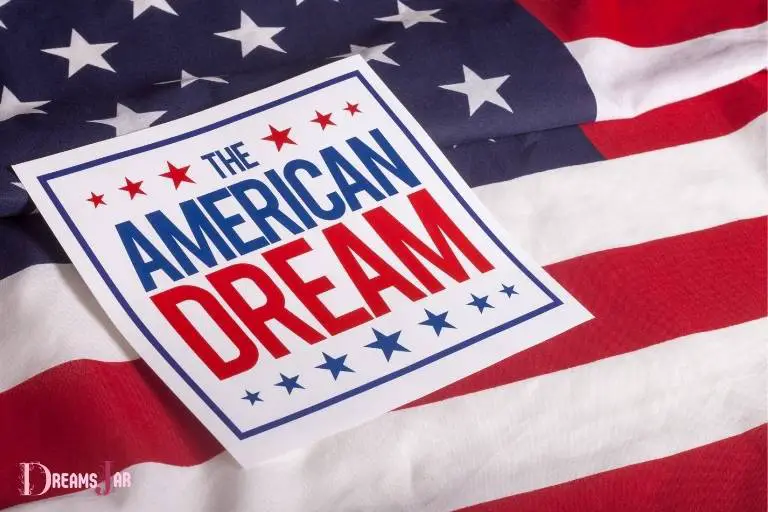What Is the Meaning of the American Dream? Determination
The American Dream is the belief that anyone can achieve success and prosperity through hard work, determination, and initiative.
This concept is deeply rooted in American society, where it signifies equal opportunity for all citizens to succeed based on their abilities, rather than on the circumstances of their birth or social status.
While the specifics of this dream vary for each individual, the underlying idea remains constant – with opportunity, hard work, and determination, anyone can succeed and achieve their goals in the United States.
6 Meaning of the American Dream
| Aspect | Description |
|---|---|
| Definition | The American Dream is the belief that anyone, regardless of their background, can achieve success and upward mobility through hard work, determination, and initiative. |
| Origin | The concept of the American Dream can be traced back to the founding of the United States, with the idea of a land of opportunity and freedom for all. |
| Key Elements | – Equal opportunity – Upward mobility – Financial success – Homeownership – Better life for one’s children |
| Criticisms | – Limited accessibility – Systemic inequality – Materialism and consumerism – Environmental impact – Unrealistic expectations |
| Evolution | The meaning of the American Dream has evolved over time, with changing societal values, economic conditions, and political landscapes influencing its interpretation. |
| Notable Figures | – James Truslow Adams (coined the term in 1931) – Benjamin Franklin (rags-to-riches success story) – Abraham Lincoln (emphasized equality) – Martin Luther King Jr. (called for racial and economic equality) – Eleanor Roosevelt (advocated for social reforms) |
Key Takeaway

Five Facts About the Meaning of the American Dream
What is the Definition of the American Dream?
The American Dream is a deeply rooted concept within American society, symbolizing the aspiration for a better life filled with prosperity, happiness, and success.
At the core of this belief is the idea that every individual has an equal opportunity to achieve their goals, regardless of their background and social standing.
The American Dream represents the pursuit of personal fulfillment, financial security, and the chance to create a better life for one’s family and future generations.
Key Elements of the American Dream:
- Equal opportunity for success
- Prosperity and financial security
- Personal fulfillment and happiness
- Upward social mobility
- A better life for one’s family and future generations
Notable Quotes about the American Dream:
“The American Dream is that dream of a land in which life should be better and richer and fuller for everyone, with opportunity for each according to ability or achievement.”
Factors that Contribute to Achieving the American Dream:
- Access to quality education and job opportunities
- Hard work, determination, and resilience
- Support from family, friends, and mentors
- Social and economic stability
In essence, the American Dream embodies the hope and promise of a better life for all citizens, driven by their own efforts, ambition, and opportunities available in the United States.
It is an essential part of the nation’s values and continues to inspire generations of Americans to strive for success and happiness.
“The American Dream is a concept that is open to interpretation and has evolved over time.”
– Senator Marco Rubio
What is the History of the American Dream?
The history of the American Dream can be traced back to the origins of the United States.
The concept embodies the idea that individuals have the opportunity to achieve prosperity, happiness, and success through hard work, determination, and upward social mobility.
- The phrase “American Dream” was popularized by historian James Truslow Adams in his 1931 book, “The Epic of America,” where he described it as “that dream of a land in which life should be better and richer and fuller for everyone, with opportunity for each according to ability or achievement.”
- Early influences on the American dream include the Declaration of Independence, which emphasizes the unalienable rights of life, liberty, and the pursuit of happiness, and the US Constitution, which establishes a framework for social mobility and equal opportunity.
- In the 19th and 20th centuries, the American Dream attracted waves of immigrants hoping for a better life in the New World. This period witnessed rapid industrialization, westward expansion, and the growth of the middle class.
- The 1950s saw the height of the American Dream, characterized by a booming economy, suburbia, and the rise of consumer culture. However, the 1960s and 1970s brought social upheaval, civil rights struggles, and a questioning of traditional values, casting doubt on the attainability of the dream.
To gain a deeper understanding of the American Dream, explore the works of authors such as F. Scott Fitzgerald, John Steinbeck, and Arthur Miller, who have provided critical perspectives on the concept throughout American history.
What is the Origin of the Term ‘American Dream’?
The origin of the term ‘American Dream’ can be traced back to the early 20th century, specifically in the writings of historian and author James Truslow Adams. In his 1931 book, “The Epic of America,” Adams popularized the term as an emblematic concept of American society.
The American Dream signifies the notion that everyone, regardless of their social class or circumstances, can achieve success and prosperity through hard work, determination, and initiative.
- The term ‘American Dream’ was first used by James Truslow Adams in 1931
- It represents the idea of equal opportunity and upward mobility for all individuals
- The concept has its roots in America’s founding principles and values
What Events Impacted the Formation of the American Dream?
The formation of the American Dream has been shaped by various pivotal events throughout history, reflecting the evolving concept of prosperity, freedom, and equality.
The American Dream embodies the idea that anyone, regardless of their social or economic background, can achieve success through hard work, determination, and ingenuity.
- Founding of America: The American Dream’s foundation lies in the establishment of the United States and the drafting of critical founding documents, such as the Declaration of Independence and the Constitution, which emphasize individual liberties and the pursuit of happiness.
- Westward Expansion: Manifest Destiny, the belief that American settlers were destined to expand across the North American continent, played a significant role in shaping the American Dream. This expansion provided land and opportunities for economic growth, encouraging self-reliance, and entrepreneurial spirit.
- Industrial Revolution: The rapid growth of factories, railways, and other industries provided job opportunities and the potential for upward mobility, attracting millions of immigrants seeking their own version of the American Dream.
- The Great Depression: This economic downturn challenged the optimism of the American Dream, as many faced financial adversity and unemployment. However, it ultimately reinforced the resilience and determination inherent in the American Dream.
- Civil Rights Movement: The fight for equal rights and opportunities for all races, religions, and genders led to a more inclusive understanding of the American Dream, highlighting the importance of social equality and justice.
When discussing the American Dream, it is essential to consider how it has been shaped by different generations, taking into account the unique challenges and opportunities they faced, as well as the diverse perspectives of various cultural, racial, and socio-economic groups.
What Values are Represented in the American Dream?
The American Dream represents a set of values and ideals that have become synonymous with the pursuit of success and happiness in the United States.
It encapsulates the belief that anyone, regardless of their background, can achieve success through hard work, determination, and perseverance.
This notion has been ingrained in the ethos of America since its inception and continues to shape the aspirations of countless individuals today.
Key values represented in the American Dream include:
- Opportunity: The belief that America offers a land of endless possibilities where individuals can pursue their goals and overcome obstacles.
- Equality: The American Dream emphasizes equal opportunity and the belief that everyone has the right to succeed, regardless of their race, gender, or background.
- Freedom: Central to the American Dream is the concept of personal and economic freedom, allowing individuals to make their own choices and forge their own paths.
- Individualism: The importance of personal responsibility and self-reliance is integral to the American Dream, encouraging individuals to achieve their goals through their own efforts.
- Material Prosperity: The pursuit of wealth and material success is often seen as a key component of the American Dream, reflecting the belief that hard work can lead to financial security and abundance.
- Democracy: The American Dream is closely tied to the nation’s democratic ideals, asserting that everyone has a voice and the right to participate in shaping society.
In conclusion, the American Dream embodies a set of values deeply entrenched in the American psyche, including opportunity, equality, freedom, individualism, material prosperity, and democracy.
These values serve as a guiding force for those seeking success and happiness in the United States and symbolize the promise of possibility that lies at the heart of the American experience.
What is the Significance of the American Dream?
The American Dream is a significant concept in American culture as it represents the idea that anyone, regardless of their background or socioeconomic status, can achieve success and upward mobility through hard work, determination, and self-improvement.
This belief has been central to American society, fueling optimism and granting individuals a sense of opportunity and hope.
- Key aspects of the American Dream include economic prosperity, homeownership, and social mobility.
- The concept has its roots in the United States Declaration of Independence, which proclaims the pursuit of happiness as an unalienable right.
- The American Dream has evolved over time, with changing societal values and economic conditions shaping its meaning and significance.
What are the Benefits of the American Dream?
The American Dream is a concept deeply rooted in American culture, representing the idea that anyone can achieve success, prosperity, and happiness through hard work and determination.
By embracing the American Dream, individuals have the opportunity to seek upward social and economic mobility, leading to a variety of significant benefits:
- Economic Opportunity: The American Dream promotes the idea that people can build a successful life regardless of their background. This fosters a strong work ethic and entrepreneurial spirit, which drives economic growth and creates job opportunities.
- Social Mobility: As a vital component of the American Dream, social mobility allows people to move up the social ladder, create a better life for themselves and their families, and break the cycle of poverty.
- Cultural Diversity: The American Dream has drawn immigrants from all around the world, contributing to a rich and diverse cultural landscape. This diversity fosters innovation, creativity, and a variety of perspectives.
- Education and Personal Growth: Belief in the American Dream encourages individuals to pursue higher education and develop their skills, which can lead to better job opportunities and personal fulfillment.
- Community Building: The pursuit of the American Dream often involves people working together to create stronger, more prosperous communities for themselves and future generations.
“The American Dream is that dream of a land in which life should be better and richer and fuller for everyone, with opportunity for each according to ability or achievement.” – James Truslow Adams, historian
dreamsjar
While the American Dream can offer numerous benefits to those who strive for it, it is essential to acknowledge that achievement of the dream may look different for each individual.
As the American Dream continues to evolve, it remains a guiding principle that encourages people to work towards creating a better life, for both themselves and their communities.
What is the Impact of the American Dream on Society?
The impact of the American Dream on society is multifaceted, shaping various aspects of American life, including culture, politics, and economics.
The American Dream embodies the belief that individuals can achieve success and prosperity through hard work and ingenuity, regardless of their background.
This idea has been a driving force behind the United States’ progress and innovation, leading to increased social mobility and economic opportunities for many.
- Influence on Immigration: The American Dream has attracted millions of immigrants to the United States, seeking better lives and opportunities, enriching American culture and diversity.
- Catalyst for Social Mobility: The belief in upward mobility has led to an ambitious and hardworking society, striving to achieve a better status and financial well-being.
- Creativity and Innovation: The American Dream fosters an atmosphere that encourages entrepreneurship and technological advancements, propelling the United States to become a global superpower in technology and business.
What are the Drawbacks of the American Dream?
The American Dream, often defined as the pursuit of success, wealth, and individualism, has long been regarded as a cornerstone of American society. ]However, it is not without its drawbacks, which have led some to question the viability and morality of this long-held belief.
- Limited access to opportunities: The dream often implies equal access to resources and opportunities, but in reality, factors like racial and economic disparities create barriers to success for many individuals.
- Pressure to conform: The American Dream can impose societal pressure on individuals to conform to certain expectations, such as obtaining a well-paying job, a house, and raising a family. This pressure can lead to stress and discontentment among those who don’t conform or who don’t achieve these goals.
- Materialism: The dream frequently focuses on material wealth as a measure of success, leading to consumerism and environmental exploitation to obtain wealth, power, and status.
- Neglect of community: The American Dream’s emphasis on individualism can lead to a devaluation of the importance of community and collective support systems.
- Economic inequality: The pursuit of the American Dream often fuels income inequality, as it incentivizes the exploitation of workers and monopolistic tendencies for personal gain.
In conclusion, while the American Dream has inspired many to strive for success, it also brings with it a series of drawbacks that can lead to societal issues like inequality, environmental degradation, and community fragmentation.
To address these challenges, a more inclusive and sustainable interpretation of the American Dream should be considered.
What is the Future of the American Dream?
The future of the American Dream is evolving as societal values and economic opportunities shift in the United States.
The traditional concept of the American Dream has long been centered around homeownership, upward mobility, and a stable job providing a comfortable lifestyle.
However, as income inequality grows and globalization impacts the job market, the younger generations are adapting their perspectives and goals.
- Reimagining success: The concept of success is shifting from material wealth to experiences and personal fulfillment. Many people are prioritizing work-life balance, mental health, and personal growth over traditional markers of success.
- Education and skills development: As automation and technological advancements alter the job market, there is an increased emphasis on continuous learning, specialized skill sets, and adaptability to maintain a competitive edge.
- Entrepreneurship: The gig economy and digital platforms have given rise to new opportunities for self-employment and entrepreneurial ventures, allowing individuals to take control of their financial futures.
- Social and environmental responsibility: There is a growing awareness of social and environmental issues, leading individuals to seek a balance between personal success and contributing to the betterment of society.
The future of the American Dream is not set in stone; it will continue to evolve as new generations face different challenges and cultural influences.
It is essential for individuals and policymakers alike to acknowledge this evolution and strive for a more inclusive, sustainable, and adaptable vision of the American Dream for all.
Stay informed about the changing economic landscape and trends to adapt and stay ahead in the pursuit of your own version of the American Dream.
Conclusion
In conclusion, the American Dream is a multifaceted concept that has evolved over time and has been shaped by historical events, cultural values, and societal developments.
It represents the idea that anyone, regardless of their background or social status, can achieve success, prosperity, and happiness through hard work, determination, and ambition. However, the American
Dream has both positive and negative implications, as it can lead to individualism, materialism, and inequality.
TL;DR:
- The American Dream is a complex and evolving concept representing the idea of achieving success, prosperity, and happiness through hard work and determination.
- It has both positive and negative implications, including individualism, materialism, and inequality.
- The American Dream remains a driving force in the American culture, but it’s important to reflect on its meaning and strive for a more inclusive and equitable society.
Action list:
- Reflect on your own interpretation of the American Dream and how it aligns with your values and goals.
- Educate yourself on the historical and cultural context of the American Dream to better understand its complexities and implications.
According to a survey conducted by YouGov, 90% of Americans still believe in the idea of the American Dream, but only 25% believe it can be attained by anyone willing to work hard.
dreamsjar
FAQ for Meaning of the American Dream
What is the American Dream?
The American Dream is the idea of the United States of America as a land of freedom and opportunity, where all citizens have the potential to live their own version of success and happiness.
How was the American Dream first defined?
The term “American Dream” was first used in 1931 by James Truslow Adams in his book The Epic of America. In it, he defined the American Dream as the opportunity for all citizens to strive for a better life, without being limited by social class or circumstances of birth.
Does the American Dream still exist today?
Yes, the American Dream still exists today. It is the belief that everyone in the United States has the opportunity to achieve success and happiness through hard work, determination, and perseverance.
What are the core values of the American Dream?
The core values of the American Dream include freedom, equality, justice, and opportunity for all. The American Dream is also about embracing hard work and taking responsibility for one’s own destiny.
What is the true meaning of the American Dream?
The American Dream is a concept that has been interpreted differently throughout history. At its core, it is the belief that anyone can achieve success and prosperity through hard work and determination.
However, the definition of success and prosperity has evolved over time. For some, it means homeownership and financial security.
For others, it means social mobility and access to education. Ultimately, the American Dream is subjective and varies from person to person.
It is an ideal that has shaped the American identity and continues to inspire people from all walks of life to pursue their aspirations.
- The idea of the American Dream dates back to the early 17th century.
- James Truslow Adams popularized the term in his 1931 book The Epic of America.
- The American Dream is often associated with immigration and the pursuit of a better life in the United States.
- The concept has been criticized for promoting individualism and ignoring systemic barriers to success, such as racism and inequality.
- Despite its flaws, the American Dream remains a powerful symbol of hope and freedom for many people around the world.
Remember that the American Dream is not a one-size-fits-all concept. As a writer, it’s important to acknowledge the diversity of experiences and perspectives that exist within this ideal.
Be open to exploring different interpretations of the American Dream and avoid making broad assumptions about what it means to all people.
Why was the American Dream?
The American Dream has been a long-standing concept that has captured the hearts and minds of people from all over the world.
It has served as the symbol of hope, prosperity, and success in the land of opportunities. Throughout history, the American Dream has evolved significantly, reflecting the changing values and aspirations of the American people.
- The concept of the American Dream can be traced back to the Declaration of Independence, which established the fundamental principles of individual liberty, equality, and the pursuit of happiness.
- The Industrial Revolution and the rise of capitalism helped to fuel the American Dream by providing unprecedented economic growth and social mobility.
- The Great Gatsby by F. Scott Fitzgerald, published in 1925, is a classic work of American literature that popularized the idea of the American Dream.
- The pursuit of the American Dream has been a driving force in American society, motivating people to work hard, take risks, and strive for success.
- While the American Dream has been a source of inspiration and optimism for many Americans, critics argue that it is an ideal that is out of reach for most people, particularly those from underprivileged backgrounds.
Regardless of its flaws and limitations, the American Dream remains a beacon of hope for millions of people around the world, a dream that encourages them to believe in their potential and strive for a better life.
- The original concept of the American Dream emphasized political and moral principles, such as freedom, democracy, and justice.
- In the 19th century, the American Dream was primarily focused on economic prosperity and social mobility, fueled by the Industrial Revolution and the rise of capitalism.
- In the 20th century, the American Dream became more closely associated with consumerism, homeownership, and nuclear family values.
- Today, the American Dream is evolving once again, as millennials and Gen Z seek more sustainable and fulfilling lifestyles, prioritizing experiences over material possessions.
What is an example of the American Dream?
The American Dream is the belief that anyone can achieve success through hard work and determination.
It’s a concept that has been a part of the American identity for centuries, and many individuals and families have lived out this dream in their own unique ways. One well-known example of the American Dream is the story of Oprah Winfrey.
She was born into poverty in Mississippi but went on to become a hugely successful media personality, philanthropist, and businesswoman.
Through her hard work, perseverance, and unwavering commitment to her vision, she has become one of the most influential people in the world.
Who Came up with the American Dream?
Although many people have contributed to the development and evolution of the American Dream, it is generally attributed to James Truslow Adams.
In his book “The Epic of America,” published in 1931, Adams describes the American Dream as “that dream of a land in which life should be better and richer and fuller for everyone, with opportunity for each according to ability or achievement.”
This idea has since become a central part of the American identity.
- The term “American Dream” was not commonly used until the 20th century.
- Historians believe that the phrase was popularized during the post-World War II era.
- The American Dream has evolved over time, and today it encompasses a variety of individual and collective aspirations.
- The American Dream has been referenced in popular culture numerous times, including in Martin Luther King Jr.’s “I Have a Dream” speech and the classic novel “The Great Gatsby.”
What are the benefits of the American Dream?
The American Dream is an ideal that has been ingrained in American culture for decades. It refers to a belief that everyone can achieve success and prosperity through hard work and determination.
While the meaning of the American Dream may vary from person to person, there are several benefits that come with pursuing it.
These benefits include increased job opportunities, upward mobility, and the freedom to pursue personal goals and aspirations.
Additionally, the American Dream fosters a sense of community, resilience, and optimism that can contribute to a more fulfilled life.
- The pursuit of the American Dream fosters creativity and innovation.
- The American Dream promotes the idea that anyone can overcome adversity and achieve their goals.
- The American Dream encourages a strong work ethic and a sense of personal responsibility.
- The American Dream promotes the value of education and lifelong learning.
- The phrase “the American Dream” was coined by James Truslow Adams in his 1931 book “The Epic of America.”
- While the benefits of pursuing the American Dream can be exciting, it’s important to remember that success and prosperity are not guaranteed. It’s important to set realistic goals, work hard, and maintain a positive attitude even in the face of setbacks.
What is the American Dream essay?
The American Dream is a term often used to describe the aspirations of immigrants to the United States. It’s a belief that anyone can succeed and prosper in the land of opportunity through hard work and determination.
While the term has different meanings for different people, it generally involves having a successful career, owning a home, and providing a better life for one’s family.
American Dream has been critiqued for being unattainable for the majority of Americans due to income inequality and structural barriers. Despite the challenges, many people still hold onto the idea of the American Dream and work towards achieving it.
- The concept of the American Dream first originated in James Truslow Adams’ book, “The Epic of America,” published in 1931.
- The American Dream has been linked to the country’s founding principles of liberty and equality.
- The dream has evolved over time to reflect changing societal values and economic realities.
- Critics argue that the American Dream places too much emphasis on material wealth and ignores social and environmental concerns.
According to a survey conducted by the Pew Research Center, 51% of Americans believe that the American Dream is “dead,” while 49% believe it’s still achievable.
What are the two American dreams?
The second version of the American dream puts a higher value on the pursuit of happiness and personal fulfillment. This dream is rooted in the idea that individuals have the right to pursue their passions and live a life that brings them true satisfaction and contentment.
Here are some key differences between the two American dreams:
- The first American dream focuses on economic success while the second places more emphasis on personal fulfillment.
- The first American dream often prioritizes money and material possessions, while the second is more concerned with non-material things like relationships and experiences.
- The first American dream is often associated with working hard and climbing the corporate ladder, while the second is associated with taking risks and following one’s heart.
Ultimately, the American dream means something different to everyone. Some people may prioritize financial success, while others may value creativity and personal growth more highly.
No matter what version of the American dream you pursue, the important thing is to stay true to yourself and work towards a life that brings you happiness and fulfillment.






